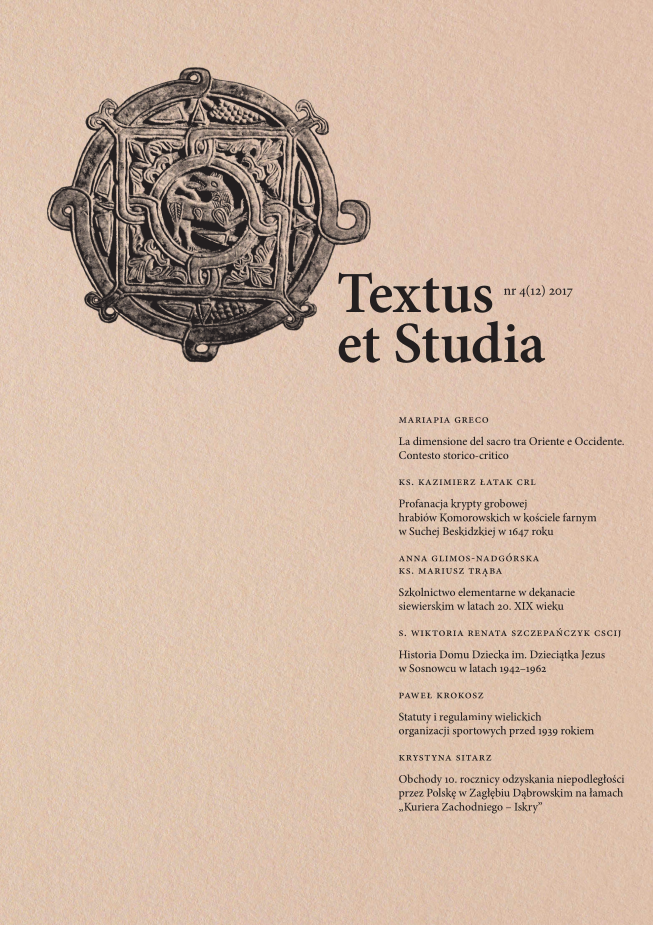La dimensione del sacro tra Oriente e Occidente. Contesto storico-critico
DOI:
https://doi.org/10.15633/tes.03401Słowa kluczowe:
sakralność, Wschód, Zachód, kontekst, religiaAbstrakt
Talking about the sacred represents a very complex and grueling effort. It is also a main topic in the debate by philosophers, poets and historians.
As we know, the sacred is interpreted and understood in different ways. Religions, for example, have often identified the sense of the sacred in symbols, rites, places, icons and precepts.
For this reason, it is difficult to elaborate a current analysis that could explain the persistence or disappearance of the sacred.
It would be natural to attempt to make reference to the myth of Nietzsche’s eternal return, meaning that the eternal does not return to the cyclicality of history that repeats itself, but the return to models, exemplary actions, archetypes of almost archaic human existence, not as individuality and temporality, but because they are connected to roots that disregard them, or rather transcends them. The ritual is a memory of a mythical event, and a repetition of the event itself, at the same time.
In this regard, Laura Tussi wrote in her thesis The symbolic and ethic-pedagogic meaning of the sacred (2001): “The event relives and repeats what happened in «illo tempore», in a past out of time. The original sacred event becomes a model, an archetype. Every ritual has a divine pattern, a paradigmatic archetype. It is supposed that all religious acts founded by gods, civilizing heroes, mythical ancestors, but also every human action, have meaning because they repeat the mythical action performed by the god, hero, ancestor, for which man repeats the act of creation. The religious calendar commemorates all cosmogonist phases from the beginning, for example the Jewish Saturday, as the «imitatio dei». The ecclesiastical liturgy is the total repetition of the life and passion of Jesus”.
This work, therefore, aims to be a starting point for desired and renewed research on the complex and current theme of the sacred.
Bibliografia
Baget Bozzo G., Dio e l’Occidente, Milano, 1995.
Eraclito, Frammenti, Milano 2013.
Euripide, Baccanti [in:] Tragedie e frammenti, vol. III, Torino 2001.
Euripide, Ione [in:] Tragedie e frammenti, vol. II, Torino 1993.
Dziwisz S., Una vita con Karol. Conversazione con Gian Franco Svidercoschi, Milano 2007.
Foucault M., Tecnologie del sé [in:] Un seminario con Michel Foucault – Tecnologie del sé, Torino 1992.
Galimberti U., Cristianesimo. La religione dal cielo vuoto, Milano 2012.
Galimberti U., Le orme del sacro, Milano 2000.
Girard R., Le bouc émissaire (1982); tr. it. Il capo espiatorio, Milano 1987.
Goethe J.W., Natur (1783); tr. it. La natura [in:] Il mio Dio, il mio Cristo, D. Goldoni (a cura di), Milano 1996.
Goethe J.W., Lettera a J.C. Lavater del 22 giugno 1781, Briefe und gespräche [in:] Gedankenausgabe der Werke, E. Beutler (a cura di), Zurigo 1966.
Jǎcov M., Giovanni Paolo II difensore dei perseguitati, dei poveri e degli emarginati [in:] Sfida di Giovanni Paolo II per l’uomo del XXI secolo, Atti del Convegno Internazionale svoltosi presso l’Università del Salento dal 15 al 18 novembre 2011, Università del Salento e Accademia Polacca delle Scienze e delle Lettere di Cracovia, Lecce 2013.
Jǎcov M., Il primo genocidio eseguito contro gli Armeni. Pierwsze ludobójstwo dokonane na Ormianach (1894–1897), Roma–Kraków 2012.
Jǎcov M., La Questione d’Oriente vista attraverso la tragedia Armena 1894–1897, Cracovia 2011.
Lippiello T., Le droghe dell’immortalità nell’antichità cinese e il Taishang lingbao zhicao pin, Venezia 2007.
Nietzsche F.W., Gaia Scienza. Idilli di Messina, S. Giametta (a cura di), aforisma 125: L’uomo folle, Milano 2015.
Nietzsche F.W., fr. 14(89) [in:] Nachgelassene Fragmente 1888-1889; tr. it. Frammenti postumi 1888–1889 [in:] Opere, vol. VIII, t. 3, Milano 1974.
Paolillo M., Il Daoismo. Storia, dottrine, pratiche, Roma 2014.
Sales F. di, Teotimo, Roma 2008.
Santini A., Giovanni Paolo II. I viaggi nel mondo. In cammino per la pace, Novara 2004.
Zhuangzi, L.V. Arena (a cura di), Milano 2009.
Pobrania
Opublikowane
Numer
Dział
Licencja
Prawa autorskie (c) 2019 Mariapia Greco

Praca jest udostępniana na licencji Creative Commons Attribution-NonCommercial-NoDerivatives 3.0 Unported License.
Autorzy publikujący w czasopiśmie udzielają jego wydawcy zgody o następującej treści:
- Autor zachowuje autorskie prawa majątkowe do utworu, a jednocześnie udziela wydawcy czasopisma zgody na jego pierwszą publikację w wersji drukowanej i wersji online na licencji Creative Commons Uznanie autorstwa 4.0 Międzynarodowe oraz zgody na wykonywanie opracowań, w tym przekładów.
- Autor ma możliwość udzielania zgody niewyłącznej na opublikowanie utworu w wersji, która ukazała się w czasopiśmie (np. zamieszczenia go w repozytorium instytucjonalnym lub opublikowania w książce), wraz z informacją o jego pierwszej publikacji w czasopiśmie.
- Autor może umieścić swój utwór online (np. w repozytorium instytucjonalnym lub na swojej stronie internetowej) jeszcze przed zgłoszeniem utworu do czasopisma.

